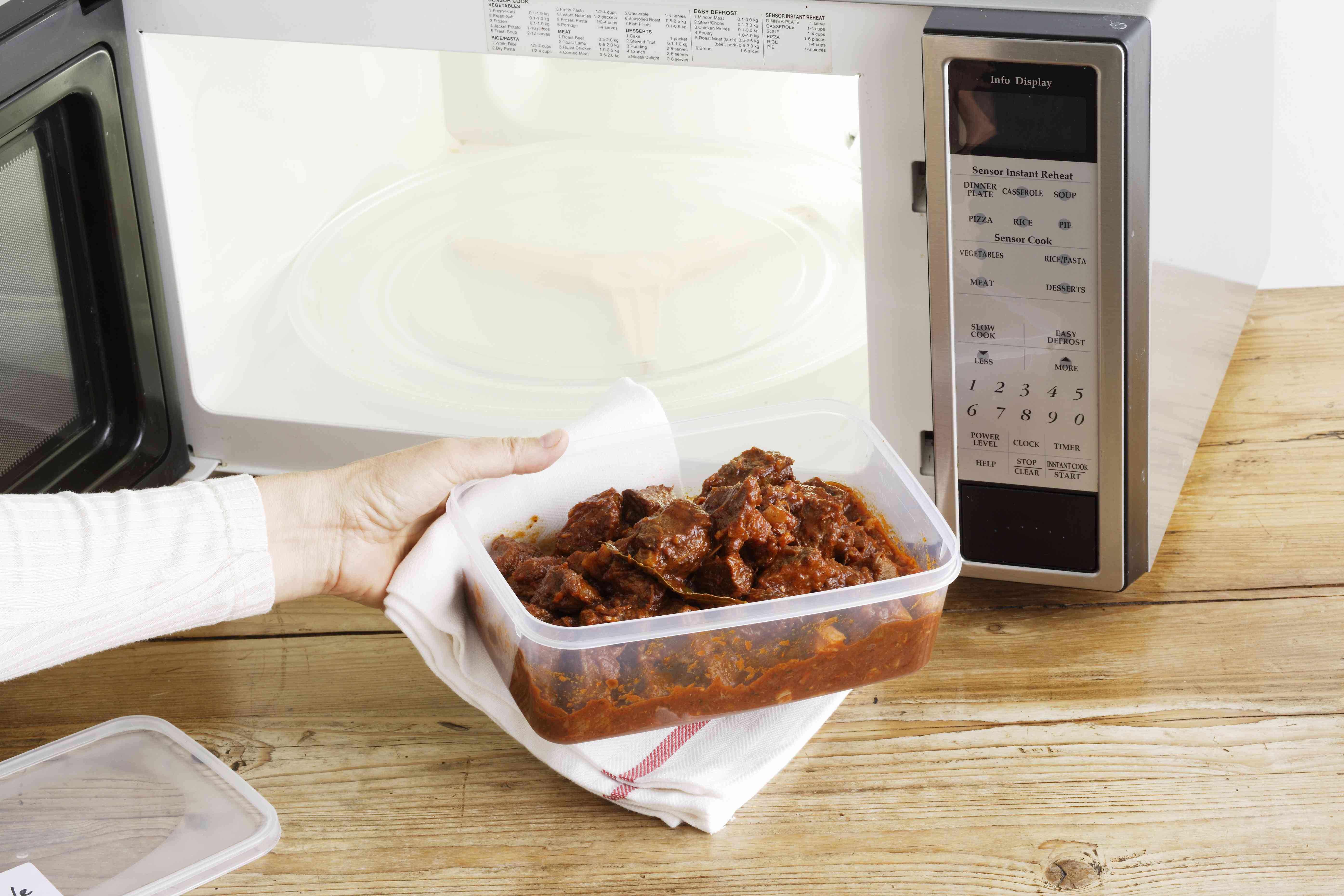Just How Bad Is It to Microwave or Freeze Plastic? Here's What Experts Say

Is it bad to eat food that's been microwaved in a plastic container? Here's what to know about microwaving, food, and exposure to microplastics and chemicals

BRETT STEVENS / Getty Images
- A new lawsuit claims that Ziploc's "microwave safe" label is misleading because microwaving can increase microplastic exposure.
- Microplastics are tiny bits of degraded plastic that may harm human health.
- Research has found that microwaving plastic containers can lead to more microplastics exposure than keeping plastic at room temperature.
Many plastic dishes and storage containers are marked “microwave safe,” but a recently filed class action lawsuit raises questions about such claims.
Specifically, the lawsuit alleges that S.C. Johnson, the company that makes Ziploc products, has misled consumers about the safety of certain Ziploc bags and containers by failing to adequately warn them that these products could release microplastics when microwaved or frozen. Despite what their labels say, these items are “fundamentally unfit for microwave and freezer use” due to the danger of microplastic exposure, the complaint claims.
“We believe Ziploc products are safe when used as directed and that the lawsuit is without merit,” an S.C. Johnson spokesperson said in a statement to Health.
Regardless of brand, is it really that bad to microwave or freeze plastic? Here’s what to know.
What Exactly Are Microplastics—and Are They Dangerous?
Microplastics are generally defined as fragments of plastic less than five millimeters long. When larger pieces of plastic degrade, microplastics are the result.
People are exposed to microplastics in all sorts of ways, from the food and water we consume to the air we breathe. As we come in contact with microplastics, they accumulate inside our bodies. Modern human brains may contain the equivalent of a plastic spoon’s worth of microplastics, according to one recent study.
Researchers are still learning about exactly how microplastic exposure affects human health—but what they do know isn’t encouraging.
“Where we’ve looked, we’ve found harm,” said Katie Pelch, PhD, a senior scientist at the National Resources Defense Council, a nonprofit devoted to protecting environmental health. Pelch recently co-authored a study analyzing past research (much of it conducted in animals) on the health effects of microplastics. She and her colleagues concluded that microplastics are “suspected“ to harm the reproductive, digestive, and respiratory systems and may be linked to colon and lung cancer.
Other studies have also raised concerns about microplastics’ impact on brain and heart health, among other issues.
Does Microwaving or Freezing Food in Plastic Increase Microplastic Exposure?
In short, yes. When certain containers made from polypropylene, a type of plastic commonly used for food packaging, were microwaved for just three minutes, they released millions upon millions of microplastic particles into their contents, one 2023 study found. Other tested storage scenarios—like keeping foods in plastic containers at room temperature—also resulted in microplastic release over time, but not at the same rate as microwaving.
Freezing foods in plastic may also increase your microplastic exposure, explained Carmen Marsit, PhD, a professor of environmental health at Emory University’s Rollins School of Public Health. “The freezing process might make the plastic more brittle, so then you might have more shedding of those microplastics into the food products,” he said.
Are There Other Risks Associated With Microwaving Plastic?
Many of the chemicals used in plastic manufacturing, including PFAS “forever” chemicals, phthalates, and BPA, are thought to threaten human health.
PFAS chemicals, alone, have been linked to health hazards ranging from increased cancer risks and decreased immunity to reproductive issues and developmental delays among children.
When plastic containers are heated in the microwave, “it’s really going to help those chemicals to leach out of the plastic and into the food,” Marsit told Health.
Sometimes, you can easily observe signs of this process. “If you notice that the plastic container gets softer [after you microwave it], that’s a good sign that chemicals are leaching out of the plastic and into the food that you’re heating up,” Pelch said.
Pelch said the type and number of chemicals you’re exposed to depend on the kind of plastic you microwaved. But, in general, it’s a good idea to avoid microwaving any plastic—even if it’s stamped with a “microwave safe” label.
A “microwave-safe” plastic container shouldn’t melt, warp, or catch fire when zapped, Marsit said. But that doesn’t necessarily guarantee safety from other risks, like chemical leaching or microplastic exposure.
Should You Stop Using Plastic in the Kitchen?
It’s near-impossible to avoid all plastics. But Pelch told Health there are some easy swaps you can—and should—make in the kitchen.
First and foremost, choose dishes that aren’t made of plastic when you need to heat or freeze food. Although you should double-check your dish’s labeling to be sure, glass and ceramic vessels are often safe for both the microwave and freezer, while stainless steel can generally be used in the freezer alone. (If you’re using a glass container with a plastic lid, remove the lid before you microwave your meal, Marsit added.)
To go further, Pelch recommends replacing other plastic items in your kitchen, such as cutting boards and blender pitchers. Also, be aware that nonstick cookware is typically coated with PFAS chemicals, which can flake off with repeated use. “They’re kind of a double whammy,” Pelch said. “Now they’re microplastics, and they’re PFAS.”
In a world where much of our food comes packaged in some type of plastic, it’s probably not feasible to go totally plastic-free. But within your own kitchen, Marsit says, it’s a good goal to “at least minimize the amount of plastic contact that food has.”
This story originally appeared on: Health News - Author:Jamie Ducharme


















